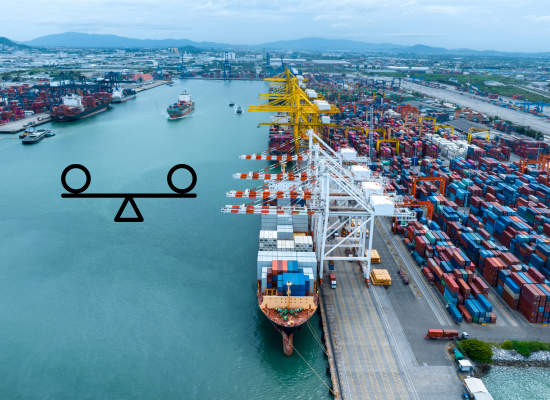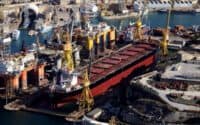The Economics of Ship Size: Balancing Bigger Vessels Against Port Limitations

In the maritime industry, the size of a vessel directly influences its operational dynamics and economic outcomes. Over recent decades, the trend toward larger vessels has been driven by the relentless pursuit of efficiency and cost-effectiveness in global trade. These giants of the sea bring with them significant economic benefits, but also present unique challenges, particularly when interfacing with port infrastructure not originally designed to accommodate them. Understanding these trade-offs is crucial for ship owners making strategic decisions about fleet composition and operational tactics.
* Please send feedback/suggestions to editor @ shipuniverse.com
The Economic Advantages of Larger Vessels
The move towards larger vessels is underpinned by several key economic advantages that can significantly impact the bottom line of shipping companies.
Economies of Scale
Cost Efficiency in Operations: One of the most compelling arguments for larger vessels is their ability to drastically reduce the cost per unit of cargo carried. Due to their larger capacity, these ships can spread the fixed costs of operation — such as crew salaries, insurance, and vessel maintenance — over a much larger volume of cargo. This scaling effect can lead to lower costs per container or ton, significantly enhancing profitability. As a result, shipping lines can offer more competitive rates, potentially increasing their market share in competitive global shipping markets.
Fuel Efficiency: Larger vessels are also typically more fuel-efficient on a per container basis. Their design and the economies of scale they bring mean that the amount of fuel used per ton-mile of cargo transported is lower than that of smaller ships. This is not only economically advantageous but also increasingly important in a world where environmental considerations are becoming paramount. However, it’s important to note that while larger ships are more fuel-efficient when fully laden, their efficiency can diminish if they are not operating at near full capacity.
Increased Carrying Capacity
The ability to transport more cargo per voyage is a pivotal factor in the maritime industry’s shift toward increasingly larger vessels. This section explores how enhanced carrying capacity not only meets the expanding demands of global trade but also provides a strategic competitive edge in bustling international markets.
Market Demand Fulfillment
As global trade continues to grow, so does the demand for efficient and cost-effective transportation solutions. Larger vessels, with their increased carrying capacity, are perfectly suited to meet this demand. For example, consider a hypothetical Ultra Large Container Ship (ULCS) that can carry 20,000 TEUs (Twenty-Foot Equivalent Units), compared to a previous generation ship that carries 10,000 TEUs. This doubling in capacity allows a single voyage to transport the same amount of cargo as two voyages by the smaller ship, effectively halving the number of trips needed to move the same volume of goods across seas.
This increased efficiency is critical in high-volume trade routes, such as those between Asia and Europe or across the Pacific to North America. By deploying larger vessels, shipping companies can respond more effectively to the peaks in demand seen during major shopping seasons like the pre-holiday rush in Western markets. Additionally, the ability to move more goods in fewer trips helps stabilize supply chains, which is particularly valuable in industries where timely delivery is crucial, such as automotive or technology sectors relying on just-in-time manufacturing processes.
Competitive Edge
Operating larger vessels provides significant competitive advantages in international shipping markets. These advantages manifest in several key areas:
- Cost Leadership: By driving down the cost per container, larger vessels enable operators to offer more competitive shipping rates. This pricing power can be a decisive factor for clients when selecting a shipping partner, particularly for price-sensitive cargoes.
- Service Attractiveness: Larger ships often translate to fewer transshipments and potentially faster end-to-end service times, making a shipping line’s service more attractive. For example, a retailer or manufacturer seeking to minimize inventory costs and reduce lead times would find a direct service with a large vessel more appealing than one requiring multiple transshipments.
- Market Presence: The sheer scale of operations possible with larger vessels can help companies establish or maintain a strong presence in key markets. They are often seen as more reliable by major shippers, as they can accommodate large volumes of cargo with ease, ensuring that capacity is less likely to be an issue even during high-demand periods.
- Environmental Impact: With increased scrutiny on the shipping industry’s environmental footprint, the improved fuel efficiency per TEU on larger vessels presents not just an economic benefit but also an environmental one. This aspect can be particularly appealing to clients who are increasingly looking for greener logistics options.
Constraints Imposed by Port Limitations
While the economic incentives for operating larger vessels are substantial, they are not without their challenges, particularly when it comes to the physical and navigational limitations imposed by port infrastructure. These limitations can significantly impact the operational flexibility and cost-efficiency of deploying larger ships.
Infrastructure Challenges
Port Accommodation: The capacity of a port to accommodate large vessels is determined by several critical infrastructure elements. One of the primary constraints is the draft limitation, which refers to the maximum depth of water a port can handle. Many older or smaller ports simply cannot accommodate the deeper drafts required by the largest modern cargo ships. For instance, while a vessel might be engineered to carry 20,000 TEUs, it would be unable to dock at a port where the water depth is insufficient for its draft.
In addition to draft limitations, the size of berths and the length of quay walls also play a crucial role. Larger vessels require longer and deeper berths to safely dock and unload, which not all ports have available. Furthermore, the availability of large cranes and other cargo-handling equipment that can reach across the wider beams of large vessels is another requirement that not all ports meet.
Navigational Challenges: Beyond the physical docking constraints, navigational complexities also pose significant challenges for large vessels at certain ports. Congested or geographically restricted ports can present difficult navigation conditions that may require special piloting skills and local knowledge. For example, ports located near urban areas or those with busy waterways may require ships to perform complex maneuvers to dock, increasing the risk of accidents or delays.
Ports with tight turns, narrow channels, or those prone to heavy traffic can further complicate the operations for large vessels. These ships have larger turning circles and require more time and space to maneuver, making them potentially unsuitable for ports with these geographical constraints. Additionally, the effect of “bank cushion” and “bank suction,” phenomena that affect large vessels due to their close proximity to shallow banks in narrow channels, can also impact navigational safety and efficiency.
Additional Costs
Operating larger vessels not only impacts shipping operations at sea but also imposes significant requirements and costs on port infrastructure on land. Two major areas where these costs manifest are in dredging requirements to accommodate these large ships and the need for more sophisticated handling equipment and technology.
Dredging Requirements
Economic and Environmental Costs: To accommodate the deeper drafts of larger vessels, many ports find themselves needing extensive dredging operations. The economic costs of dredging are significant, involving not only the initial dredging but also ongoing maintenance dredging to keep the channels and berths at the required depths. For example, the expansion of the Panama Canal, which included extensive dredging to accommodate larger vessels, cost over $5 billion. Such costs need to be justified by the increased revenue from accommodating larger ships.
From an environmental perspective, dredging can have serious impacts. It can disturb marine ecosystems, release toxins trapped in seabed materials, and increase turbidity which can smother aquatic plants and impact fish populations. Managing these environmental issues requires careful planning, monitoring, and the implementation of mitigation measures, which can further increase the costs.
Handling Equipment and Technology
Investments in Advanced Equipment: Larger vessels also necessitate investments in advanced cargo-handling equipment and technology. The size and volume of cargo these ships carry require more sophisticated, faster, and more robust cranes and other loading/unloading equipment. For instance, ports may need to invest in new gantry cranes with greater reach and lifting capacity to handle containers from larger vessels efficiently.
Moreover, the integration of technology such as automation and robotics has become essential in managing the increased cargo volumes efficiently and minimizing turnaround times. Systems like automated stacking cranes and automated guided vehicles (AGVs) are becoming more prevalent in modern ports that service large container ships.
Cost of Technological Upgrades: The cost of such technological upgrades can be substantial. For example, the installation of automated systems and the purchase of new cranes can run into millions of dollars. However, these investments are often necessary to maintain competitive service levels and operational efficiency. The return on these investments is seen in the form of faster service times, reduced labor costs, and the ability to service more and larger vessels, which can increase a port’s throughput significantly.
Balancing Benefits and Limitations
Navigating the complexities of operating larger vessels involves strategic decision-making to balance the inherent benefits and limitations. This section explores the crucial aspects of strategic port selection and the operational trade-offs that shipping companies face.
Strategic Port Selection
Choosing Strategic Ports of Call: In the landscape of global shipping, not all ports are capable of handling the largest vessels, which necessitates selective and strategic port choices by shipping companies. These decisions are driven by several factors including the port’s infrastructure capabilities—such as draft depth, berth size, and available handling equipment—and its geographical and economic relevance to major trade routes. For instance, major ports like Shanghai, Singapore, and Rotterdam are preferred for large vessel operations due to their advanced facilities and strategic locations on key shipping lanes.
Furthermore, the selection process also considers the business volume and the nature of cargo being transported. Ports with significant industrial outputs or import needs are more likely to be included in the network for large vessels to maximize cargo loads per voyage, enhancing the cost-efficiency further.
Alliances and Partnerships: To effectively accommodate large vessels, shipping companies often enter into alliances and partnerships. These collaborations allow for sharing resources such as berthing slots and joint use of handling facilities. By pooling resources, member companies can reduce operational costs and enhance schedule reliability. Alliances also provide leverage in negotiations with port authorities and service providers, allowing for better terms and further cost reductions. This is especially critical in ports where capacity and demand are high, making optimal slot allocation essential.
Size Versus Flexibility
Versatility in Smaller Markets: While large vessels bring economies of scale, they lack the flexibility required to operate in smaller or more restrictive markets. This limitation is due to several factors such as the lack of suitable port infrastructure, the geographical constraints of certain regions, and the smaller volume of trade, which might not justify the use of a very large vessel.
Shipping companies often have to balance the benefits of using large vessels on major routes with the need to maintain service to smaller markets. This might involve deploying a mix of large and smaller vessels, where large ships handle major legs of global trade routes, and smaller ones take over for regional distribution. This strategy, however, requires careful management to ensure efficiency and cost-effectiveness across the mixed fleet.
Trade-Offs and Strategic Considerations: Operating a mixed fleet allows companies to leverage the cost benefits of large vessels while retaining the market reach and service frequency offered by smaller ships. However, it also introduces complexity in operations, such as transshipment needs and coordination challenges. The key lies in accurately forecasting demand and aligning fleet capabilities with market needs to optimize returns without compromising service quality.
While the advantages of economies of scale and enhanced carrying capacity provide compelling incentives for adopting mega-ships, the challenges posed by port limitations and the need for significant infrastructural investments cannot be overlooked. Shipping companies must navigate these waters with a keen eye on both global trade dynamics and local port capabilities to strike an optimal balance that maximizes efficiency and profitability. As the industry continues to evolve, the ability of ports to accommodate these giants and the strategic decisions of shipping companies will play pivotal roles in shaping the future of global shipping. Through careful planning, robust partnerships, and continual adaptation to technological advancements, the maritime sector can harness the full potential of larger vessels while mitigating the associated risks.

Do you have any feedback or additional insights? Please reach out to editor @ shipuniverse.com




